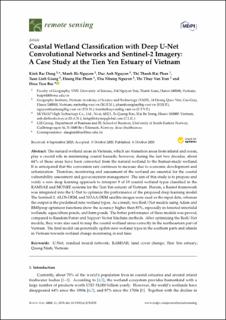| dc.contributor.author | Dang, Kinh Bac | |
| dc.contributor.author | Nguyen, Manh Ha | |
| dc.contributor.author | Nguyen Duc, Anh | |
| dc.contributor.author | Phan, Thi Thanh Hai | |
| dc.contributor.author | Giang, Tuan Linh | |
| dc.contributor.author | Pham, Hoang Hai | |
| dc.contributor.author | Nguyen, Thu Nhung | |
| dc.contributor.author | Tran, Thi Thuy Van | |
| dc.contributor.author | Tien Bui, Dieu | |
| dc.date.accessioned | 2021-04-07T13:06:24Z | |
| dc.date.available | 2021-04-07T13:06:24Z | |
| dc.date.created | 2020-10-08T16:35:45Z | |
| dc.date.issued | 2020 | |
| dc.identifier.citation | Dang, K. B., Nguyen, M. H., Nguyen, D. A., Phan, T. T. H., Giang, T. L., Pham, H. H., ... & Bui, D. T. (2020). Coastal Wetland Classification with Deep U-Net Convolutional Networks and Sentinel-2 Imagery: A Case Study at the Tien Yen Estuary of Vietnam. Remote Sensing, 12(19), Artikkel 3270. | en_US |
| dc.identifier.issn | 2072-4292 | |
| dc.identifier.uri | https://hdl.handle.net/11250/2736678 | |
| dc.description.abstract | The natural wetland areas in Vietnam, which are transition areas from inland and ocean, play a crucial role in minimizing coastal hazards; however, during the last two decades, about 64% of these areas have been converted from the natural wetland to the human-made wetland. It is anticipated that the conversion rate continues to increase due to economic development and urbanization. Therefore, monitoring and assessment of the wetland are essential for the coastal vulnerability assessment and geo-ecosystem management. The aim of this study is to propose and verify a new deep learning approach to interpret 9 of 19 coastal wetland types classified in the RAMSAR and MONRE systems for the Tien Yen estuary of Vietnam. Herein, a Resnet framework was integrated into the U-Net to optimize the performance of the proposed deep learning model. The Sentinel-2, ALOS-DEM, and NOAA-DEM satellite images were used as the input data, whereas the output is the predefined nine wetland types. As a result, two ResU-Net models using Adam and RMSprop optimizer functions show the accuracy higher than 85%, especially in forested intertidal wetlands, aquaculture ponds, and farm ponds. The better performance of these models was proved, compared to Random Forest and Support Vector Machine methods. After optimizing the ResU-Net models, they were also used to map the coastal wetland areas correctly in the northeastern part of Vietnam. The final model can potentially update new wetland types in the southern parts and islands in Vietnam towards wetland change monitoring in real time. | en_US |
| dc.language.iso | eng | en_US |
| dc.relation.uri | https://www.mdpi.com/2072-4292/12/19/3270 | |
| dc.rights | Navngivelse 4.0 Internasjonal | * |
| dc.rights.uri | http://creativecommons.org/licenses/by/4.0/deed.no | * |
| dc.title | Coastal Wetland Classification with Deep U-Net Convolutional Networks and Sentinel-2 Imagery: A Case Study at the Tien Yen Estuary of Vietnam | en_US |
| dc.type | Peer reviewed | en_US |
| dc.type | Journal article | en_US |
| dc.description.version | publishedVersion | en_US |
| dc.rights.holder | © The Author(s). | en_US |
| dc.source.volume | 12 | en_US |
| dc.source.journal | Remote Sensing | en_US |
| dc.source.issue | 19 | en_US |
| dc.identifier.doi | https://doi.org/10.3390/rs12193270 | |
| dc.identifier.cristin | 1838286 | |
| dc.source.articlenumber | 3270 | en_US |
| cristin.ispublished | true | |
| cristin.fulltext | original | |
| cristin.qualitycode | 1 | |

